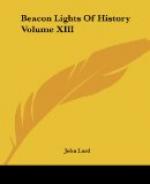We now revert to the poet’s early, or, rather, to his middle-age, creative years, and to a resume of his principal writings, with a brief, running comment on his message and art. In 1847, three years before he became Laureate, he published “The Princess,” a charming narrative poem in blank verse, which, though it abounds in fine descriptions and has an obvious moral in the treatment of the theme,—the woman question of today,—is inherently lacking in unity and strength, as well as weak in the depicting of the characters. In later editions the poem was amended in several faulty respects, and was especially enriched by the insertion between the cantos of many lovely and now familiar songs, which serve not only to bind together the whole structure of the poem, but to enhance and enforce its high moral meaning. Any analysis of “The Princess” is here deemed unnecessary, since it must not only be familiar to most readers of the poet’s works, but familiar also in the varied annotated editions of such editors as Rolfe, Woodberry, and Wilson Farrand. Familiar, it is believed, also, that it will be to Tennysonian students in the “Study of the Princess,” with critical and explanatory notes by Dr. S.E. Dawson, of Montreal (now of Ottawa, Canada),—an able commentary which received the approval of Lord Tennyson himself, and elicited from him a highly interesting letter to the author on points in the poem either misunderstood or not discerningly apprehended by other critics and reviewers. The purport of the poem, it may be said, however, is to frown upon revolutionary attempts to alter the position of women, of scholastically be-gowned and college-capped dames, who would seek by other than nature’s ways to put the sex upon an equality with man, while repressing their own individuality, doing violence to their maternal instincts, and trampling upon their “gracious household ways.” In the handling of the “medley” Tennyson brings into exercise not only his far-seeing powers, which were greatly in advance of his time, but his gifts of raillery and humor, especially in the early divisions of the poem, as well as his high, serious motives in the moral lessons to which he points in the later cantos, where he aims at the elevation of women in correspondence with the diversity of their natures, for, as he himself says, “Woman is not undeveloped man, but diverse.” His ideal of perfect womanhood he would attain through the awakening power of the affections and the transforming power of love, rather than by ignoring the difference of physique, founding women’s universities, and becoming blue-stockinged high priestesses of learning. Of the medley of characters in the poem, poet-princes in disguise at the college, violet-hooded lady principals,




